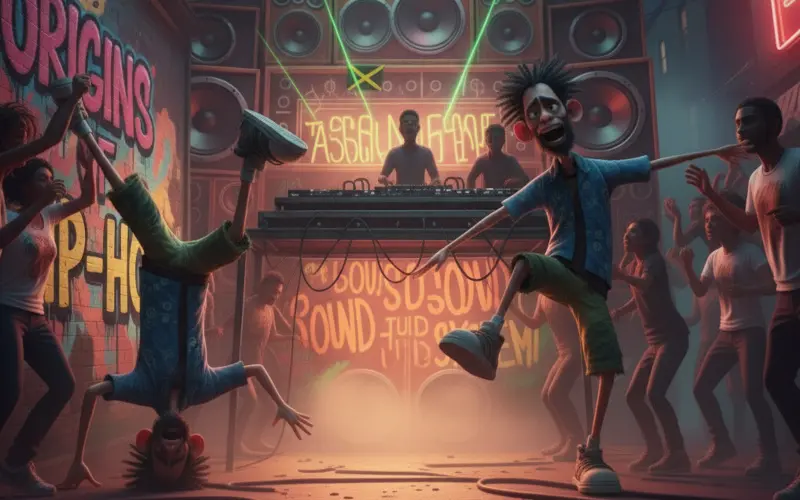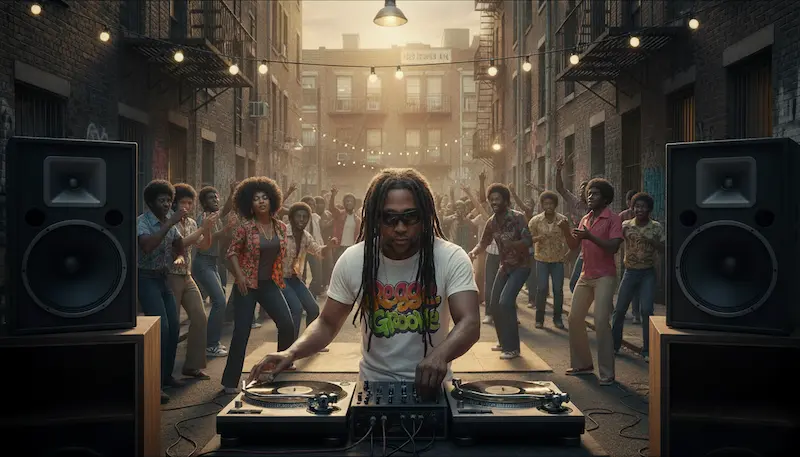
Introduction: Hip-Hop More Than a Bronx Story
When you ask people where hip-hop started, most will say the Bronx in the 1970s, and, although this is correct, it doesn’t provide the complete picture.
The origins link back to Kingston, Jamaica, across the Caribbean Sea. Hip-hop is a cultural exchange between these two places: one known for reggae, dub, and large sound systems, the other, a New York borough filled with funk, soul, and vibrant creativity.
What’s interesting—and often overlooked—is that many elements of hip-hop were first explored in Kingston. The fierce competitions between Jamaican Sound Systems, the deejay “toasts,” and the love for bass that shakes your chest were all in place before the Bronx scene really took off.
To comprehend the roots of hip-hop, we have to go back to Jamaican street parties, where the heavy bass and rhythm were already established.
I. The Jamaican Blueprint: A Culture Built on Bass
In the 1950s and 60s, Jamaica thrived with a unique form of entertainment that blended community gathering with musical experimentation. These were the Jamaican Sound Systems—mobile parties that brought music to neighborhoods without clubs or concert halls. These were not merely trucks outfitted with speakers; they were meticulously engineered systems aimed at producing intense vibrations.
Every system had a selector, who chose the records, and a deejay, who engaged the crowd by talking—or toasting—over instrumental “versions” of popular songs. A skillfully delivered toast could elevate a lively party to a near-religious experience.
Sound clashes—battles between rival systems—were the ultimate test. Crews showed up with custom speakers, exclusive records, and deejays primed to energize the crowd. The system that got the loudest reaction won.
This model already hinted at what would become hip-hop. The Jamaican impact on hip-hop is clear in retrospect: a culture driven by competition, improvisational vocals, and bass-focused beats that united the community.

II. The Man Who Brought the Sound: DJ Kool Herc and Hip Hop Roots
Let’s talk about DJ Kool Herc, born Clive Campbell in Kingston in 1955. He grew up surrounded by sound system culture, watching how selectors and deejays could energize a crowd with rhythm and wordplay.
When his family moved to the Bronx in 1967, he brought more than just clothes—he brought memories of speakers so loud they felt like they could lift you off the ground.
By the early 1970s, the Bronx faced tough times. Poverty and crime were rampant, and many young people sought an escape. Parties became essential, but most New York DJs played records straight, lacking the drama Herc remembered from Jamaica.
So he adjusted. Drawing on his roots, Herc started hosting Bronx block parties, bringing in huge speakers and focusing on bass-heavy records that hit harder than the disco sounds popular on the radio. His approach may not have been polished, but it was raw, loud, and enthralling. Crowds were drawn to his events because they were exhilarating..
When asked who created hip-hop, Herc’s name usually comes up first. That’s because he firmly planted hip-hop’s roots in the Bronx, yet they stretched back to Jamaica.
III. The Breakthrough: The Origin of The Break and the Toast
Historians often identify a Bronx block party in 1973 as the start of hip-hop. At that event, Herc observed something crucial: the crowd went wild during the short, drum-heavy segments of funk and soul records known as the break.
Instead of letting the break play once and then end, Herc used two turntables to loop it. While one record played the break, he queued up the same section on the other deck. By switching between the two, he kept that percussive beat going indefinitely.
This became the “Merry-Go-Round” technique, and with it, Herc created the breakbeat—the foundation of hip-hop production.
Herc wasn’t alone on the mic. His friend, Coke La Rock, hyped the crowd by talking over the beats and adding playful rhymes. This should sound familiar. Coke’s improvisational toasting drew inspiration from Jamaican deejays who had been doing the same over dub versions back home.
This was the American take on what King Tubby and U-Roy had already been experimenting with in Kingston: simplifying tracks, emphasizing rhythm, and letting the voice float on top. The link was formed by reggae sound systems which formed the bridge to enable the new sound of hip-hop to establish.
IV. A New Genre is Born: The Roots of Hip Hop Culture
Once Herc figured it out, the Bronx exploded with imitators and innovators. Grandmaster Flash refined mixing techniques, getting better at cutting and scratching records. Afrika Bambaataa created a cultural movement around the music, seeing it as more than just sound—it was a lifestyle.
Together, they defined what we now recognize as the four elements of hip-hop:
- DJing (the technical manipulation of sound),
- MCing (the lyrical voice of the culture),
- Breakdancing (the physical expression of rhythm),
- Graffiti (the visual language of the streets).
All of these grew from the improvisational, community-focused, and competitive nature of hip-hop culture—all qualities directly inherited from Jamaican Sound Systems.
Interestingly, this wasn’t a one-way exchange. As hip-hop developed, Jamaican artists began returning the favor.
By the 1980s, dancehall musicians were rapping in styles influenced by American MCs. This back-and-forth enriched both cultures.

V. The Enduring Influence: Jamaican Influence on Hip Hop and Beyond
Fast forward to today, and you can hear elements of that Jamaican sound system influence everywhere. The hip-hop origin story isn’t just a chapter in history—it lives on in the music itself.
When rappers energize a crowd with call-and-response chants, they’re following the tradition established by Jamaican deejays. When producers focus on bass drops that make cars rattle, they’re channeling the same intensity that sound system engineers used in Kingston’s dancehalls.
Even outside hip-hop, electronic dance music, dubstep, and jungle draw from that same foundation. The evolution of hip-hop shows that musical styles do not develop in isolation,but are influenced by movement, memories, and the fusion of cultures.

VI. Key Moments in the Hip Hop Origin Timeline
- 1950s–60s, Kingston: Rise of Jamaican Sound Systems; selectors and deejays set the template.
- 1967, Bronx: Clive Campbell (later DJ Kool Herc) emigrates from Jamaica.
- 1973, Bronx block party: Kool Herc pioneers the “Merry-Go-Round” breakbeat technique.
- Mid-1970s: Coke La Rock introduces live toasting at Herc’s parties.
- Late 1970s: Grandmaster Flash, Afrika Bambaataa, and others expand hip-hop’s reach and refine techniques.
1980s onward: Hip-hop and Jamaican dancehall influence each other in an ongoing exchange.

VII. Conclusion: Listening Back to Move Forward
The story of hip-hop is often framed as an exclusively American creation, born on Bronx sidewalks, but the reality is more complex. Without Kingston’s Jamaican Sound Systems and their influence on hip-hop, there might not have been breakbeats, MCing, or hip-hop as we know it.
To hear this connection, try this simple exercise: play a King Tubby dub “version,” then one of DJ Kool Herc’s favorite funk breaks. The connection isn’t just historical—it’s auditory. The spaces, echoes, and rhythms link back to a cultural exchange across the ocean.
That’s the true magic of the hip-hop origin story. It’s not just about one Bronx block party; it’s about how communities under pressure created joy, creativity, and strength through sound.
Frequently Asked Questions About the Hip Hop Origin
Who created hip hop?
Most historians credit DJ Kool Herc, a Jamaican immigrant in the Bronx, as the founder of hip-hop. In 1973, he extended the drum-heavy “breaks” of funk and soul records at a Bronx block party, laying the groundwork for modern hip-hop. Nonetheless, hip-hop thrived due to a collective effort, with trailblazers such as Grandmaster Flash and Afrika Bambaataa molding the culture alongside him.
What was “The Break” in hip hop?
“The Break” refers to the instrumental drum section of a song, often the funkiest, most danceable part. At early Bronx parties, DJ Kool Herc looped these breaks on two turntables to keep dancers moving longer. This technique—now called the breakbeat—became the heartbeat of hip-hop music.
How did Jamaican Sound Systems influence hip hop?
Hip-hop took many cues from Jamaican Sound Systems, which were mobile parties in Kingston. The practice of “toasting” (talking or rhyming over instrumentals), large bass-heavy speaker setups, and the competitive party vibe all made their way into Bronx block parties, forming the foundation of hip-hop.
When did the first Bronx block party happen?
The most noted early Bronx block party occurred on August 11, 1973, at 1520 Sedgwick Avenue, hosted by DJ Kool Herc. Many consider this event the official start of hip-hop, even though the culture was developing before then.
What are the four elements of hip hop?
The main elements are usually listed as:
- DJing (turntablism and mixing),
- MCing (rapping and crowd hyping),
- Breakdancing (also called b-boying or b-girling),
- Graffiti art (visual street expression).
These grew from the community-driven creativity of the Bronx in the 1970s.
These emerged from the community-driven creativity of the Bronx in the 1970s.





